Japanese and Okinawan language and history. Other languages as well. Asks, messages, and requests welcome ☆沖縄☆ Fluent: English | Near-fluent: Japanese | Advanced: German, Dutch | Internediate: Okinawan, Korean, Mandarin | Beginner: Greek, Polish, Russian, Welsh | "I can read usually": Thai
Don't wanna be here? Send us removal request.
Photo




Shuri Castle is a Ryukyuan gusuku - Shuri, Okinawa
22 notes
·
View notes
Video
Senza titolo da akira asakura Tramite Flickr: yomitan, okinawa 読谷村、沖縄
251 notes
·
View notes
Photo







「いつか」は待っていてもずっと来ないし、自分で作っていくもの。
| Instagram | Facebook | INDY |
3K notes
·
View notes
Photo




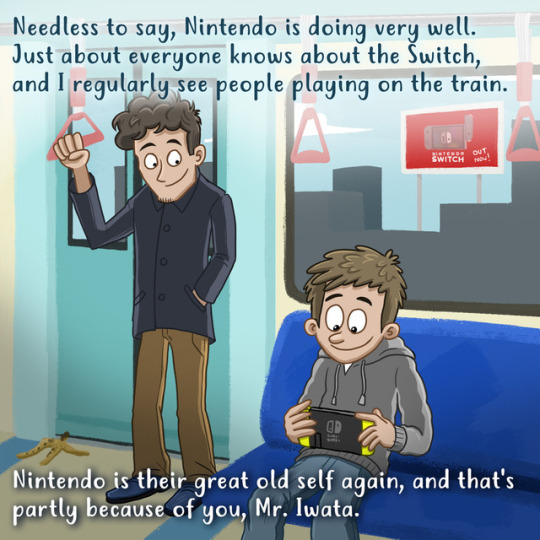
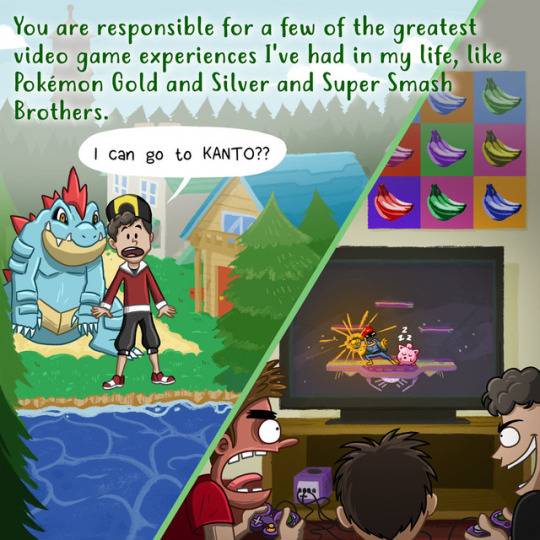
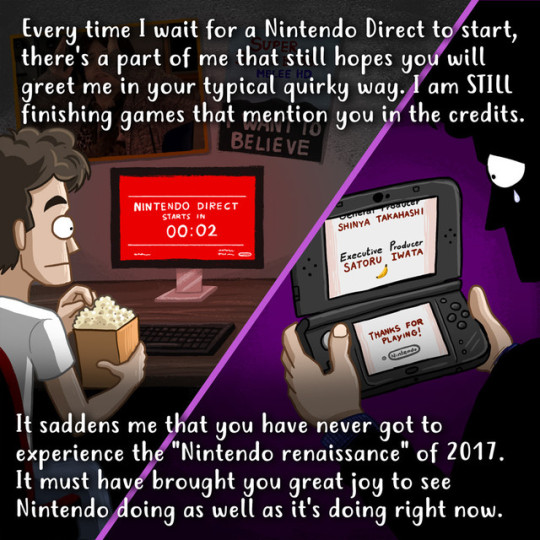
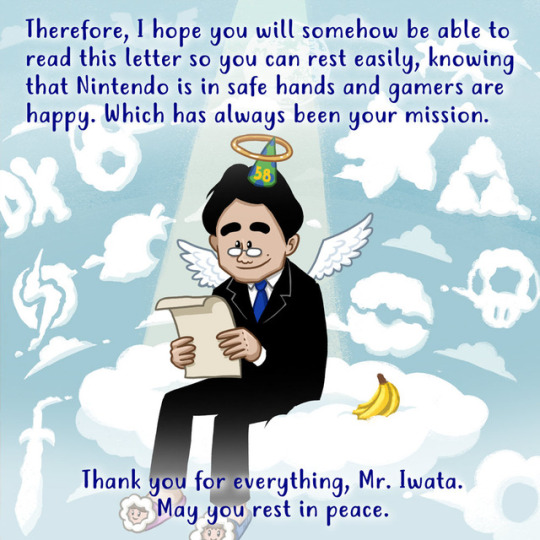
This comic has been reposted with permission from the original artist.
I found this excellent and touching comic by Reddit user AbelHagen earlier.
Happy Birthday Satoru Iwada!
Nintendo is doing just fine.
32K notes
·
View notes
Text
Japanese shape vocab
直線(ちょくせん)- straight line 曲線(きょくせん)- curve 放物線(ほうぶつせん)- parabola 平行(へいこう)- parallel 交わる(まじわる)- to intersect 実線(じっせん)- solid line 点線(てんせん)- dotted line 丸・円(まる・えん)- circle 三角・三角形(さんかく・さんかくけい)- triangle 四角・四角形(しかく・しかくけい)- square 長方形(ちょうほうけい)- rectangle 正方形(せいほうけい)- square 台形(だいけい)- trapezoid 楕円(だえん)- oval 二等辺三角形(にとうへんさんかくけい)- isoceles triangle 正三角形(せいさんかくけい)- equilateral triangle 多角形(たかくけい)- polygon 球(きゅう)- globe 立方体(りっぽうたい)- cube 直方体(ちょくほうたい)- rectangular parallelepiped 円柱(えんちゅう)- column 角柱(かくちゅう)- prism 円錐(えんすい)- cone 角錐(かくすい)- pyramid
654 notes
·
View notes
Text
I wish some people would understand that the ridiculous thing about weeaboos isn’t Japanese culture. Like what I’m trying to say is that weeaboos are ridiculous for being obsessed with Japanese culture, it’s not the culture itself that’s ridiculous. But I see people who make fun of the thing being obsessed over [japan] rather than the people obsessing over something they have no claim to. Like I met a guy who thought simply being Asian made you a weeaboo. As if the embarrassing part of weeaboos is the Asian culture. And it sucks bc in turn it makes it hard for actual Japanese diaspora to connect to their culture without feeling insecure about it and like it’s some kind of joke. The bad thing about weeaboos is their appropriation of a culture they have no connection to and their obsession with it, not the culture itself!!
119 notes
·
View notes
Link
Gorgeous! And an example of true cultural exchange between two artists from two cultures collaborating.
Also - did I mention gorgeous??? Holy heck!
“While the designs retained the robe’s traditional shape, the fabric used in the creations are sourced primarily from Senegal and Nigeria, according to Nigerian site Konbini.“
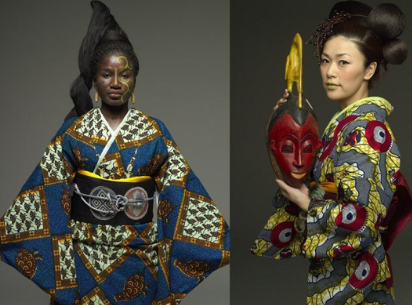
43K notes
·
View notes
Text
24 Invaluable Skills To Learn For Free Online This Year
Here’s an easy resolution: This stuff is all free as long as you have access to a computer, and the skills you learn will be invaluable in your career, and/or life in general.
1. Become awesome at Excel.
Chandoo is one of many gracious Excel experts who wants to share their knowledge with the world. Excel excellence is one of those skills that will improve your chances of getting a good job instantly, and it will continue to prove invaluable over the course of your career. What are you waiting for?
2. Learn how to code.
littleanimalgifs.tumblr.com
Perhaps no other skill you can learn for free online has as much potential to lead to a lucrative career. Want to build a site for your startup? Want to build the next big app? Want to get hired at a place like BuzzFeed? You should learn to code. There are a lot of places that offer free or cheap online coding tutorials, but I recommend Code Academy for their breadth and innovative program. If you want to try a more traditional route, Harvard offers its excellent Introduction to Computer Science course online for free.
3. Make a dynamic website.
You could use a pre-existing template or blogging service, or you could learn Ruby on Rails and probably change your life forever. Here’s an extremely helpful long list of free Ruby learning tools that includes everything from Rails for Zombies to Learn Ruby The Hard Way. Go! Ruby! Some basic programming experience, like one of the courses above, might be helpful (but not necessarily required if you’re patient with yourself).
4. Learn to make a mobile game.
If you’re not interested in coding anything other than fun game apps, you could trythis course from the University of Reading. It promises to teach you how to build a game in Java, even if you don’t have programming experience! If you want to make a truly great game, you might want to read/listen up on Game Theory first.
5. Start reading faster.
Spreeder is a free online program that will improve your reading skill and comprehension no matter how old you are. With enough practice, you could learn to double, triple, or even quadruple the speed at which you read passages currently, which is basically like adding years to your life.
6. Learn a language!
With Duolingo, you can learn Spanish, French, Portuguese, Italian, or English (from any of the above or more). There’s a mobile app and a website, and the extensive courses are completely free.
Full disclosure: BuzzFeed and other websites are in a partnership with DuoLingo, but they did not pay or ask for this placement.
7. Pickle your own vegetables.
Tired of your farmer’s market haul going bad before you use it all? Or do you just love tangy pickled veggies? You too can pickle like a pro thanks to SkillShare and Travis Grillo.
8. Improve your public speaking skills.
You can take the University of Washington’s Intro to Public Speaking for free online. Once you learn a few tricks of the trade, you’ll be able to go into situations like being asked to present at a company meeting or giving a presentation in class without nearly as much fear and loathing.
9. Get a basic handle of statistics.
UC Berkeley put a stats intro class on iTunes. Once you know how to understand the numbers yourself, you’ll never read a biased “news” article the same way again — 100% of authors of this post agree!
10. Understand basic psychology.
Knowing the basics of psych will bring context to your understanding of yourself, the dynamics of your family and friendships, what’s really going on with your coworkers, and the woes and wonders of society in general. Yale University has its Intro to Psychology lectures online for free.
11. Make your own music.
Step one: Learn how to play guitar: Justin Guitar is a fine and free place to start learning chords and the basic skills you’ll need to be able to play guitar — from there, it’s up to you, but once you know the basics, just looking up tabs for your favorite songs and learning them on your own is how many young guitar players get their start (plus it’s an excellent party trick).
Step two: A delightful free voice lesson from Berklee College Of Music.
Step three: Have you always thought you had an inner TSwift? Berklee College of Music offers an Introduction to Songwriting course completely for free online. The course is six weeks long, and by the end of the lesson you’ll have at least one completed song.
Step four: Lifehacker’s basics of music production will help you put it all together once you have the skills down! You’ll be recording your own music, ready to share with your valentine or the entire world, in no time!
12. Learn to negotiate.
Let Stanford’s Stan Christensen explain how to negotiate in business and your personal life, managing relationships for your personal gain and not letting yourself be steamrolled. There are a lot of football metaphors and it’s great.
13. Stop hating math.
If you struggled with math throughout school and now have trouble applying it in real-world situations when it crops up, try Saylor.org’s Real World Math course. It will reteach you basic math skills as they apply IRL. Very helpful!
14. Start drawing!
All kids draw — so why do we become so afraid of it as adults? Everyone should feel comfortable with a sketchbook and pencil, and sketching is a wonderful way to express your creativity. DrawSpace is a great place to start. (I also highly recommend the book Drawing on the Right Side of the Brain if you can drop a few dollars for a used copy.)
15. Make your own animated GIF.
BuzzFeed’s own Katie Notopoulos has a great, simple guide to making an animated GIF without Photoshop. This is all you need to be the king or queen of Tumblr or your favorite email chains.
16. Appreciate jazz.
reddit.com
Have you never really “gotten” jazz? If you want to be able to participate in conversations at fancy parties and/or just add some context to your appreciation of all music, try this free online course from UT Austin.
17. Write well.
Macalester College’s lecture series is excellent. If you’re more interested in journalism, try Wikiversity’s course selection.
18. Get better at using Photoshop.
Another invaluable skill that will get you places in your career, learning Photoshop can be as fun as watching the hilarious videos on You Suck At Photoshop or as serious as this extensive Udemy training course (focused on photo retouching).
19. Take decent pictures.
Lifehacker’s basics of photography might be a good place to start. Learn how your camera works, the basic of composition, and editing images in post-production. If you finish that and you’re not sure what to do next, here’s a short course on displaying and sharing your digital photographs.
20. Learn to knit.
Instructables has a great course by a woman who is herself an online-taught knitter. You’ll be making baby hats and cute scarves before this winter’s over!
21. Get started with investing in stocks.
If you are lucky enough to have a regular income, you should start learning about savings and investment now. Investopedia has a ton of online resources, including this free stocks basics course. Invest away!
22. Clean your house in a short amount of time.
Unf$#k Your Habitat has a great emergency cleaning guide for when your mother-in-law springs a surprise visit on you. While you’re over there, the entire blog is good for getting organized and clean in the long term, not just in “emergencies.” You’ll be happier for it.
23. Start practicing yoga.
Most cities have free community classes (try just searching Google or inquiring at your local yoga studio), or if you’re more comfortable trying yoga at home, YogaGlohas a great 15-day trial and Yome is a compendium of 100% free yoga videos. If you’re already familiar with basic yoga positions but you need an easy way to practice at home, I recommend YogaTailor’s free trial as well.
24. Tie your shoelaces more efficiently.
It’s simple and just imagine the minutes of your life you’ll save!
252K notes
·
View notes
Text
The Nightmare Before Christmas: This is Halloween Multilingual

English
French
Spanish (LA)
Spanish (EUR)
Polish

Italian
Arabic
German
Russian
Hungarian

Portuguese (BR)
German
Japanese
Korean
Persian

Thai
Dutch
Slovak
ASL
5K notes
·
View notes
Text
Heyaaaa, most of the tumblrs I’ve been following are inactive. So let’s do something, I’m planning to do a SUPER-DUPER-EXTRA MASTERPOST on active studyblrs that track posts. This means, REBLOG this post with your tracking hashtag so that studyblrs can use them knowing that someone will see their posts!!! 🌸
1K notes
·
View notes
Text
How to Write a University-level Essay
Heyo, so school is fast approaching, and seeing as Tumblr is made up of a lot of younger users who will soon be shipping off to college or university soon, I thought I would take it upon myself to help spread my knowledge of essay-writing. Essay-writing is my thing. I love it. I live for it. It’s how I make up for my shitty test marks, and still get by with an 85 average+ in University classes. I’m a historian by trade, so perhaps this information will seem a bit off from what you’re used to, but hopefully, It’ll help you out. If you have any questions, feel free to shoot me an ask.
1. Consider your question and find your thesis.
I know, I know. People always say, no! Never start with your thesis/intro paragraph! Go to the body!! Well i’m here to say forget everything you’ve been told. Forget that, forget the stupid hamburger shit they teach you, forget it all and start reading.
I ALWAYS start with my thesis. Why? Because you cannot make good paragraphs without knowing what you’re researching. You need direction, and a thesis is your map.
So, the question we’ll use shall be: What is one way in which the Union won the American Civil War?
Now remember, your thesis is your map. It shows you where to go, what to look for. The thesis is the heart and soul of all your work. You want a good, solid thesis. What does that include, you ask?
An idea
A reason for said idea
Evidence to support said reason, and thus validate the idea.
So, lets do an example. Let’s say I’m writing on the use of media during the American Civil War. I like photography, and wrote a paper on this in my second year, but im gonna be doing this example freehand(idk where I put that essay lol) so lets work with how I got an A+ on that paper. This will be my idea:
“Photography during the American Civil War influenced the war’s outcome in the Norths favour.”
This is VERY vague. This is an example of a thesis in bloom! Let’s take it further. Look at the above. What questions would you have from this thesis?
-Who was taking photos at that time?
-Why did it influence the outcome?
-How did it influence the outcome?
-Who consumed photography as a media at that time?
This is where you STOP, and start the next step.
2. Research
Start your basic research with your idea, and the above questions in mind. Look at libraries, ask your professor or TA or librarian, or just do some basic google searches to get to know the subject(but for the love of god if you include a google link in your citation I will personally hunt you down and castrate you.)
I like to start with the basics of any inquiry: WHO, WHAT, WHERE, WHEN, WHY, HOW. Who was taking photos? Where were they displayed that caused influence? ect…These, in relation to your beginner thesis, will help guide you in what form your thesis will take.
Once you’ve finished that, and have a general feel for the time period, go back to your thesis.
3. THESIS 2.0
Go back to your original question: What is one way in which the Union won the American Civil War? Now look at your thesis again. It’s too vague, isn’t it?
As you can see, our original thesis was too vague to be a real thesis. So, we NARROW IT DOWN using our WWWWWH progress we focused on during early research!
“Photography during the American Civil war influenced the war’s outcome by providing a visual for ordinary citizens about the horrors of war, and thus helping to increase donations and awareness to the cause.”
Great! But once again, too vague! Questions that may arise include:
Who was taking the photos
Evidence for donations?
Evidence for social awareness?
So, we NARROW IT DOWN again. I’m going to use Andrew Gardner’s photography during the Civil war, as he was one of the most famous and influential at the time.
“Andrew Gardner’s photography during the American Civil war influenced the war’s outcome by providing a visual for ordinary citizens about the horrors of war, and thus helping to increase donations and enlistment in the Union through awareness to the cause…”
The above then gives us the following(why and how are sometimes grouped together):
Who: Andrew Gardner
What: Photography helped the north win the war.
Where: Union-aka northern states
When: American Civil War
Why/How: Because Andrew Gardner’s photography raised social awareness through this new and budding medium
Use this sort of outline to guide you in the next step!
4. Now that we have a thesis, you need to do some more research and evidence gathering.
The way I like to do this is to go check out a few books from the library(look for text books in particular), and leaf through the index for matching terms. Our matching terms would be:
Photography, civil war, Andrew Gardner, media
From there, you read over the pages, and see if any of the info relates to your subjects. Copy down quotes, page numbers, book title, author, publishing date and publisher. You need these for your bibliography. Pick and choose relevant information. The filter for relevant information relies entirely on your thesis, because it decides what you need to be looking for—this is why I hate when people tell me to start writing paragraphs before I write a thesis! It’s simply impossible and counter productive, and will cost you hours in revision.
So, gather your information from the library, and cross-reference with peer-reviewed articles and data. For our thesis, we would need data on enlistment numbers in an area after a date of Andrew Gardner’s photography exhibit showcases. No matter what type of essay you’re writing, you can always back up your evidence with data, and it won’t hurt one bit. Don’t be afraid of the numbers, kids!
So, if we were to go back to our thesis, we could now expand on it like this:
“Andrew Gardner’s photography during the American Civil war influenced the war’s outcome by providing a visual for ordinary citizens about the horrors of war, and thus helping to increase donations and enlistment in the Union through awareness to the cause. An increase in donations and enlistment in relation to exposure to Gardners work is seen in data/evidence point A, as well as in data/evidence point B, which will be fully outlined in the points below.”
This gives you an example of how to lead from a thesis, to your opening paragraph.
5. Data and Evidence Justifications–Paragraph making
This is the section where you can branch your essay into your data and evidence points you gathered in steps 2 and 4. You can have as many paragraphs as you like, just make sure your evidence and data is strong and supported. I personally like to work with my thesis copied and pasted onto the top of every page I write on. This keeps you on track, with your clear goal in mind, and will help you from straying. I will give you an example of how a paragraph might sound.
Andrew Gardner’s photography during the American Civil War became heavily influential upon the American population at the time, particularly the north, wherein which his work was showcased. The influence of Gardner’s photographic works is seen in the _____, which shows us that without the influence of Gardner’s media influence, war efforts and awareness may not have been as successful as they had been.
This is an alright opener for you to work with. The ___ is where you could put in your data point or evidence piece. The point of the paragraph is to show your support for your thesis by confirming it with evidence.
Your paragraphs should take this form:
Present, Confirm, Conclude, Lead.
You present your evidence, confirm its relation to the thesis and confirm the validity of the thesis, conclude by brief revision of evidence, and then lead into your next paragraph.
6. Conclusion
Your conclusionary paragraph should be a look-over of the above paragraphs. Restate your thesis, present a summarized version of your paragraphs(one or two sentences only), and perhaps take the time to look at your own views on the subject. An example might look like this:
“Taking a moment to step away from the above mentioned evidence, I believe it to be scholarly acceptable and even necessary to state my own views on the subject presented. In drawing conclusions, I felt that the above information was correct in that it presented a reality of the time period, in which photography was becoming a medium to be embraced by popular society. People were not only astounded by Gardner’s photographs on a social level, but also a technical level. The astonishment people held at seeing the war-torn battle fields spurred them into action, and even today can still present feelings of dread, fear and loss when looking at his photos…blah blah blah”
Why is it scholarly acceptable and perhaps necessary to state your views? Oftentimes, it is to reassure the reader of your own personal bias’, which exist whether you like them or not, to the subject at hand. Having a small tidbit on your own thoughts about your research ect, breaking away from the third-person droning of an essay can be refreshing and welcoming for a prof at the end of his stack of essay reading.
7. In summary
Thesis
WWWWWH
NARROW IT DOWN
Data and Evidence
Present, Confirm, Conclude, Lead
Self opinions/Conclude
All in all, do unique things. Professors love it when they come across something that’s not cookie cutter! Even if they present you with a list of essay topics, take the leap and ask them if you can do your own research topic!! Take risks with your essay writing, talk to your professors about what you want to do, and try to have fun with your research. I’ve written on everything from civil war photography to Disney princesses in american media, to the religious formation of idea of heaven and earth. Remember, so long as there’s credible, documented evidence, it’s possible to write about it.
56K notes
·
View notes
Text
Countries and Islands in Japanese
Thank you @leo-does-languages for letting me use your format!
Also side-note: many of these are just the English or Portuguese names of the countries transcribed into katakana, as Japan did not have much foreign contact before the 1600s.
Afghanistan アフガニスタン
Albania アルバニア
Algeria アルジェリア
Andorra アンドラ
Angola アンゴラ
Anguilla アンギラ
Antigua & Barbuda アンティグア・バーブーダ
Argentina アルゼンチン
Armenia アルメニア
Australia オーストラリア
Austria オーストリア
Azerbaijan アゼルバイジャン
Bahamas バハマ
Bahrain バーレーン
Bangladesh バングラデシュ
Barbados バルバドス
Belarus ベラルーシ
Belgium ベルギー
Belize ベリーズ
Benin ベニン
Bermuda バーミューダ
Bhutan ブタン
Bolivia ボリビア
Bosnia & Herzegovina ボスニアヘルツェオビナ
Botswana ボツワナ
Brazil ブラジル
Brunei Darussalam ブルネイ
Bulgaria ブルガリア
Burkina Faso ブルキナファソ
Myanmar/Burma ミャンマー
Burundi ブルンジ
Cambodia カンボジア
Cameroon カメルーン
Canada カナダ
Cape Verde カボベルデ
Cayman Islands ケーマン諸島(けーまんしょとう)
Central African Republic 中央アフリカ共和国(ちゅうおうあふりかきょうわこく)
Chad チャド
Chile チリ
China 中国(ちゅうごっく)
Colombia コロンビア
Comoros コモロ
Congo コンゴ
Costa Rica コストリカ
Croatia クロアチア
Cuba キューバ
Cyprus キプロス
Czech Republic チェコ
Democratic Republic of the Congo コンゴ民主共和国(こんごみんしゅきょうわこく)
Denmark デンマーク
Djibouti ジブチ
Dominican Republic ドミニカ共和国(どみにかきょうわこく)
Dominica ドミニカ
Ecuador エクアドル
Egypt エジプト
El Salvador エルサルバドル
Equatorial Guinea 赤道ギニア(せきどうぎにあ)
Eritrea エリトリア
Estonia エストニア
Ethiopia エチオピア
Fiji フィジ
Finland フィンランド
France フランス
French Guiana フランス領ギアナ
Gabon ガボン
Gambia ガンビア
Georgia ジョージア
Germany ドイツ
Ghana ガーナ
Great Britain イギリス
Greece ギリシャ
Grenada グレナダ
Guadeloupe グアダルーペ
Guatemala グアテマラ
Guinea ギニア
Guinea-Bissau ギニアビサウ
Guyana ギアナ
Haiti ハイチ
Honduras ホンジェラス
Hungary ハンガリー
Iceland アイスランド
India インド
Indonesia インドネシア
Iran イラン
Iraq イラク
Israel and the Occupied Territories イスラエル
Italy イタリア
Ivory Coast (Cote d'Ivoire) ���ートジボワール
Jamaica ジャマイカ
Japan 日本(にほん、にっぽん)
Jordan ジョーダン
Kazakhstan カザフスタン
Kenya ケニア
Kosovo コソボ
Kuwait クウェート
Kyrgyz Republic (Kyrgyzstan) キルギスタン
Laos ラオス
Latvia ラトビア
Lebanon レバノン
Lesotho レソト
Liberia リベリア
Libya リビア
Liechtenstein リヒテンシュタイン
Lithuania リトアニア
Luxembourg ルクセンブルグ
Republic of Macedonia マケドニア
Madagascar マダガスカル
Malawi マラウィ
Malaysia マレーシア
Maldives マルディブ
Mali マリ
Malta マルタ
Martinique マルティニーク
Mauritania モーリタニア
Mauritius モーリシャス
Mayotte メイヨット
Mexico メキシコ
Moldova, Republic of モルドバ
Monaco モナコ
Mongolia モンゴリア
Montenegro モンテネグロ
Montserrat モンセラット
Morocco モロッコ
Mozambique モザンビーク
Namibia ナミビア
Nepal ネパール
Netherlands オランダ
New Zealand ニュージーランド
Nicaragua ニカラグア
Niger ニジェール
Nigeria ナイジェリア
Korea, Democratic Republic of (North Korea) 北朝鮮(きたちょうせん)、朝鮮民主主義人民共和国(ちょうせんみんしゅしゅぎじんみんきょうわこく)
Norway ノルウェー
Oman オマーン
Pakistan パキスタン
Panama パナマ
Papua New Guinea パプアニューギニア
Paraguay パラグアイ
Peru ペルー
Philippines フィリピン
Poland ポーランド
Portugal ポルトガル
Puerto Rico プエルトリコ
Qatar カタール
Reunion レユニオン
Romania ローマニア
Russian Federation ロシア
Rwanda ルワンダ
Saint Kitts and Nevis セントキッツ・ネイビス
Saint Lucia セントルシア
Saint Vincent's & Grenadines セントビンセント・グレナディーン
Samoa サモア
Sao Tome and Principe サントメプリンシペ
Saudi Arabia サウジアラビア
Senegal セネガル
Serbia セルビア
Seychelles セイシェル
Sierra Leone シエラレオネ
Singapore シンガポール
Slovak Republic (Slovakia) スロバキア
Slovenia スロベニア
Solomon Islands ソロモン諸島(そろもんしょとう)
Somalia ソマリア
South Africa 南アフリカ(みなみあふりか)
Korea, Republic of (South Korea) 韓国(かんこく)
South Sudan
Spain スペイン
Sri Lanka スリランカ
Sudan スダン
Suriname スリナム
Swaziland スワジランド
Sweden スウェーデン
Switzerland スイス
Syria シリア
Tajikistan タジキスタン
Tanzania タンザニア
Thailand タイ
Timor Leste 東ティモール
Togo トーゴ
Trinidad & Tobago トリニダード・トバゴ
Tunisia チュニシア
Turkey トルコ
Turkmenistan トルクメニスタン
Turks & Caicos Islands タークス・カイコス諸島(たーくす・かいこすしょとう)
Uganda ウガンダ
Ukraine ウクライナ
United Arab Emirates アラブ首長国連邦(あらぶしゅちょうこくれんぽう)
United States of America (USA) アメリカ
Uruguay ウルグアイ
Uzbekistan ウズベキスタン
Venezuela ベネズエラ
Vietnam ベトナム
Virgin Islands (UK) イギリス領ヴァージン諸島(あめりかりょうヴぁーじんしょとう)
Virgin Islands (US) アメリカ領ヴァージン諸島(あめりかりょうヴぁーじんしょよう)
Yemen イエメン
Zambia ザンビア
Zimbabwe ジンバブエ
Some Useful Suffixes: These can go on the end of any country
人(じん)or の人(のひと)- person from that country/place
アメリカ人、アメリカ領ヴァージン諸島の人
語(ご) - language of that country
日本語、オランダ語 (this really only works for a set of countries and there are some languages that are derived entirely differently, like 英語)
627 notes
·
View notes
Text
Countries and islands in Spanish
Afganistán: Afghanistan.
Albania: Albania.
Alemania:Germany.
Andorra: Andorra.
Angola: Angola.
Antigua y Barbuda: Antigua and Barbuda.
Arabia Saudita: Saudi Arabia.
Argelia: Algeria.
Argentina: Argentina.
Armenia: Armenia.
Aruba: Aruba.
Australia: Australia.
Austria: Austria.
Azerbaiyán: Azerbaijan.
Bahamas: Bahamas.
Bahrain: Bahrain.
Bangladesh: Bangladesh.
Barbados: Barbados.
Bielorrusia / Belarús: Belarus.
Bélgica: Belgium.
Belice: Belize.
Benín: Benin.
Bermudas: Bermudas.
Bolivia: Bolivia.
Bosnia: Bosnia.
Botswana: Botswaba.
Brasil: Brazil.
Brunéi Darussalam: Brunei Darussalam.
Bulgaria: Burlgaria.
Burkina Faso: Burkina Faso.
Burundi: Burundi.
Bután: Bhutan.
Camboya: Cambodia.
Camerún: Cameroon.
Canadá: Canada.
Cabo Verde: Cape Verde.
Chad: Chad.
Chile: Chile.
China: China.
Chipre: Cyprus.
Ciudad del Vaticano: Vatican City.
Colombia: Colombia.
Comoras: Comoros.
Congo: Congo.
Corea del Norte: North Korea.
Corea del Sur: South Korea.
Costa de Marfil: Ivory Coast.
Costa Rica: Costa Rica.
Croacia: Croatia.
Cuba: Cuba.
Dinamarca: Denmark.
Yibuti / Djibouti: Djibouti.
Dominica: Dominica.
Ecuador: Ecuador.
Egipto: Egypt.
El Salvador: El Salvador.
Emiratos Árabes Unidos: United Arab Emirates.
Eritrea: Eritrea.
Eslovenia: Slovenia.
España: Spain.
Estados Unidos (EE.UU.): United States
Estonia: Estonia.
Etiopía: Ethiopia.
Fiji: Fiji.
Filipinas: Philippines.
Finlandia: Finland.
Francia: France.
Gabón: Gabon.
Gambia: Gambia.
Georgia: Georgia.
Ghana: Ghana
Granada: Grenada.
Grecia: Greece.
Groenlandia: Greenland.
Guadalupe: Guadalupe.
Guam: Guam.
Guatemala: Guatemala.
Guayana Francesa: French Guiana.
Guinea: Guinea.
Guinea-Bissau: Guinea-Bissau.
Guinea Ecuatorial: Equatorial Guinea.
Guyana: Guyana.
Haití: Haiti.
Honduras: Honduras.
Hungría: Hungary.
India: India.
Indonesia: Indonesia.
Irak / Iraq: Iraq.
Irán: Iran.
Irlanda: Ireland.
Islandia: Iceland.
Islas Caimán: Cayman Islands.
Islas Faroe: Faroe Islands.
Islas Malvinas: Falkland Islands.
Islas Marshall: Marshall Islands.
Islas Salomón: Solomon Islands.
Islas Vírgenes Británicas: British Virgin Islands.
Islas Vírgenes de los Estados Unidos: American Virgin Islands.
Israel: Israel.
Italia: Italy.
Jamaica: Jamaica.
Japón: Japan.
Jersey: Jersey.
Jordán / Jordania: Jordan.
Kazajistán / Kazakstán: Kazakhstan.
Kenia: Kenya.
Kiribati: Kiribati.
Kuwait: Kuwait.
Kirguistán / Kirguizistán: Kyrgyzstan.
Laos: Laos.
Lesoto: Lesotho.
Letonia: Latvia.
Líbano: Lebanon.
Liberia: Liberia.
Libia: Libya.
Liechtenstein: Liechtenstein.
Lituania: Lithuania.
Luxemburgo: Luxembourg.
Macedonia: Macedonia.
Madagascar: Madagascar.
Malasia: Malaysia.
Malaui / Malawi: Malawi.
Maldivas: Maldives.
Malí / Mali: Mali.
Malta: Malta.
Marruecos: Morocco.
Martinica: Martinique.
Mauricio: Maurice.
Mauritania: Mauritania.
México: Mexico.
Micronesia: Micronesia.
Moldova / Moldavia: Moldavia.
Mónaco: Monaco.
Mongolia: Mongolia.
Mozambique: Mozambique.
Myanmar: Myanmar.
Namibia: Namibia.
Nepal: Nepal.
Nicaragua: Nicaragua.
Níger: Niger.
Nigeria: Nigeria.
Noruega: Norway.
Nueva Zelanda: New Zealand.
Omán: Oman.
Países Bajos: Netherlands.
Pakistán: Pakistan.
Palestina: Palestine.
Panamá: Panama.
Papúa Nueva Guinea: Papua New Guinea.
Paraguay: Paraguay.
Perú: Peru.
Polinesia Francesa: French Polynesia.
Polonia: Poland.
Portugal: Portugal.
Puerto Rico: Puerto Rico.
Qatar: Qatar.
Reino Unido: United Kingdom.
República Centroafricana: Central African Republic.
República Checa: Czech Republic.
República Democrática del Congo: Democratic Republic of Congo.
República Dominicana: Dominican Republic.
República Eslovaca: Slovak Republic.
Ruanda: Rwanda.
Rumania / Rumanía: Romania.
Rusia: Russia.
Sahara Occidental: Occidental Sahara.
Samoa: Samoa.
San Cristóbal y Nieves / Saint Kitts y Nevis: Saint Kitts and Nevis.
San Marino: San Marino.
San Vicente y las Granadinas: Saint Vincent and the Grenadines.
Santa Helena: Saint Helena.
Santa Lucía: Saint Lucia.
Santo Tomé y Príncipe: São Tomé and Príncipe.
Senegal: Senegal.
Seychelles: Seychelles.
Sierra Leona: Sierra Leone.
Singapur: Singapore.
Siria: Syria.
Somalía: Somalia.
Sri Lanka: Sri Lanka.
Suazilandia: Swaziland.
Sudán: Sudan.
Sudán del Sur: South Sudan.
Suecia: Sweden.
Sudáfrica: South Africa.
Suiza: Switzerland.
Surinam: Surinam.
Tailandia: Thailand.
Taiwán: Taiwan.
Tanzania: Tanzania.
Tayikistán: Tajikistan.
Timor Oriental: East Timor.
Togo: Togo.
Tokelau: Tokelau.
Tonga: Tonga.
Trinidad y Tobago: Trinidad and Tobago.
Túnez: Tunisia.
Turkmenistán: Turkmenistan.
Turquía: Turkey.
Ucrania: Ukraine.
Uganda: Uganda.
Uruguay: Uruguay.
Uzbekistán: Uzbekistán.
Vanuatu: Vanuatu.
Venezuela: Venezuela.
Vietnam: Vietnam.
Yemen: Yemen.
Zambia: Zambia.
Zimbabwe: Zimbabwe.
What should I do next?
340 notes
·
View notes
Text
@thisisnotclickbait don't forget that I told u to remind me ü
Tag your friend who made you learn a new language
43 notes
·
View notes
Text
I can’t see an American Kimi no Na Wa im sorry…there’s so much Japanese lore that inspires the whole movie and uhh what will it be without it???
I have a feeling America would limit it to a body swapping love story when…..it’s….so much fucking more in reality it’s just so much more….it doesn’t even have to be about love for the movie to be a work of art it’s literally everything else like the symbolism and the imagery and the story lore that make this movie so fuckimg insane….
13 notes
·
View notes
Text
Yes! Sorry for not specifying.
In general, when I use “Okinawan” I am referring to Uchinaaguchi, and use Miyako, Yaeyama, and Yonaguni specifically when I talk about those. The reason for this is because within Okinawa Prefecture, the term Okinawa refers to only Okinawa Island, and the other islands are referred to by their respective names. It is a bit weird to me to call Okinawa by its name in Uchinaaguchi, because then I would feel obligated to call the others by their names in their respective languages. However, seeing as this way of speaking is problematic I will be very sure to be clear in the future.
Edit: People studying the Ryukyu Islands tend to refer to the Ryukyuan languages as Okinawan, Yonaguni, Yaeyama, Miyako, Amami, Tokunoshima, Yoron, Kunigami, Okinoerabu, and Kikai. These are the names that are usually accepted in the community, because each have different names in both those languages and Japanese, and some of these names group the languages together inaccurately or are too similar to be used effectively.
Some Okinawan Words
In modern Okinawa, even though Okinawan is spoken mostly by the older population of the island, people are still familiar with a fairly large number of Okinawan words and phrases. Most of these are quite common.
To show contrast with Japanese, I’ll put the Japanese in parentheses after the Okinawan.
Hello (fem.) - はいたい(こんにちは)
Hello (masc.) - はいさい(こんにちは)
Thank you - にふぇーでーびる(ありがとう)
Welcome - めんそーれー(ようこそ、いらっしゃいませ)
Nice to meet you - はじみてぃやーさい(はじめまして)
Good morning - うきみそーちー(おはよう)
Good evening - ちゅーがなびら(こんばんは)
Good night - ゆくいみそーれ(おやすみなさい)
Okinawa - ウチナー(沖縄)
Okinawan person - うちなーんちゅ(沖縄の人)
You can add -んちゅ to any place to refer to a person from that place.
Yaeyama - いぇーま(八重山)
Miyako - なーく(宮古)
Good luck! - ちばりよー!(がんばれ!)
Don’t worry - しわさんけー(心配しないで)
Yes - うー(はい)
No - うぅーうぅー(いいえ)
798 notes
·
View notes
Text
七五三 - Shichi-Go-San
Shichi-Go-San, literally meaning “7-5-3,” is one of Japan’s two major coming of age holidays. Although it is officially celebrated on November 15th, the celebrations usually come the weekend after.

The holiday is a day of prayer and celebration for girls age 3 and 7, and boys age 3 and 5, because odd numbers are traditionally seen as lucky. Although the holiday began in the Heian Period (平安時代), it wasn’t until samurai culture became widespread that Shichi-Go-San gained most of its modern traditions.
A type of candy known as “Chitose-ame” or “candy of a thousand years” (千歳飴) is given to children on this holiday. The packaging has a picture of a crane and a turtle on it, which are both animals that are symbols of longevity and health.

The age 3 is chosen because traditionally, this is the age that parents begin to let their children grow their hair longer. While this practice is no longer as widespread as it once was, the age of 3 still remains an important milestone.
Boys at the age of 5 wear what is called a hakama (袴) for the first time during Shichi-Go-San in a celebration called hakamagi (袴着). Similarly, at the age of 7, girls transition from wearing thin strands on their kimono to the thick, decorated band known as an obi (帯) during a celebration called obitoki (帯解き).
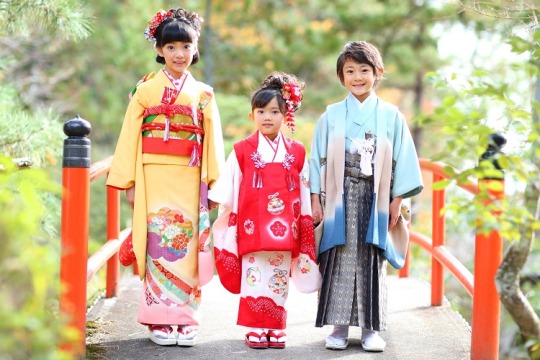
341 notes
·
View notes